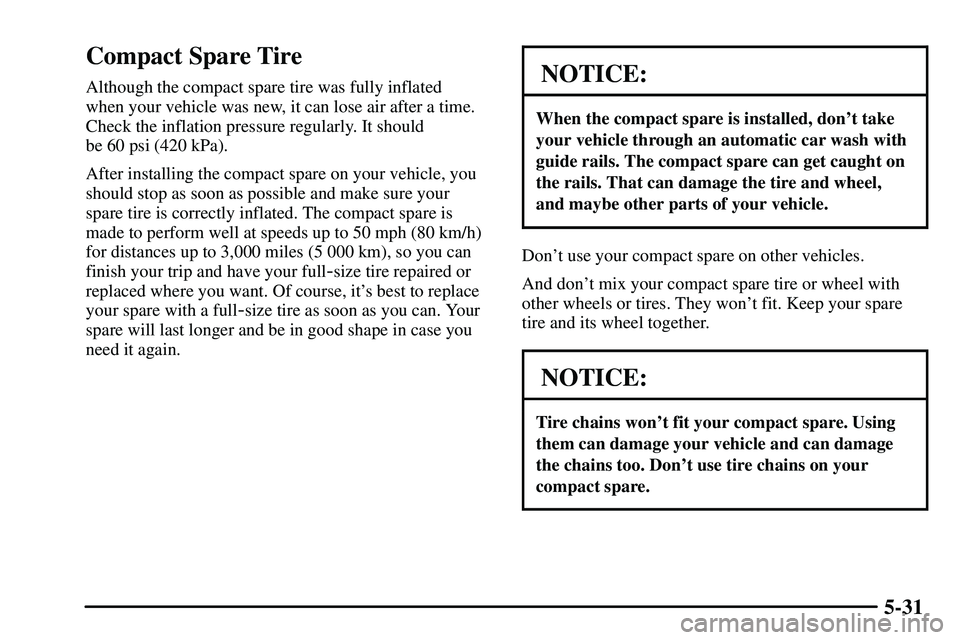Page 235 of 381
5-24
3. Raise the vehicle by turning the jack handle
clockwise. Raise the vehicle far enough off the
ground so there is enough room for the compact
spare tire to fit underneath the wheel well.
4. Remove all the wheel
nuts and take off the
flat tire.
5. Remove any rust or dirt
from the wheel bolts,
mounting surfaces and
spare wheel.
Page 236 of 381
5-25
CAUTION:
Rust or dirt on the wheel, or on the parts to
which it is fastened, can make the wheel nuts
become loose after a time. The wheel could come
off and cause an accident. When you change a
wheel, remove any rust or dirt from the places
where the wheel attaches to the vehicle. In an
emergency, you can use a cloth or a paper towel
to do this; but be sure to use a scraper or wire
brush later, if you need to, to get all the rust or
dirt off.
CAUTION:
Never use oil or grease on studs or nuts. If you
do, the nuts might come loose. Your wheel could
fall off, causing a serious accident.
6. Reinstall the wheel nuts with the rounded end of the
nuts toward the wheel. Tighten each nut by hand
until the wheel is held against the hub.
Page 237 of 381
5-26
7. Lower the vehicle by turning the jack handle
counterclockwise. Lower the jack completely.
8. Tighten the wheel
nuts firmly in a
crisscross sequence
as shown.
Page 238 of 381
5-27
CAUTION:
Incorrect wheel nuts or improperly tightened
wheel nuts can cause the wheel to become loose
and even come off. This could lead to an accident.
Be sure to use the correct wheel nuts. If you have
to replace them, be sure to get new GM original
equipment wheel nuts.
Stop somewhere as soon as you can and have the
nuts tightened with a torque wrench to the
proper torque specification. See ªCapacities and
Specificationsº in the Index for the wheel nut
torque specification.
NOTICE:
Improperly tightened wheel nuts can lead to
brake pulsation and rotor damage. To avoid
expensive brake repairs, evenly tighten the wheel
nuts in the proper sequence and to the proper
torque specification. See ªCapacities and
Specificationsº in the Index for the wheel nut
torque specification.
Page 239 of 381
5-28 Storing the Flat Tire and Tools
CAUTION:
Storing a jack, a tire or other equipment in the
passenger compartment of the vehicle could
cause injury. In a sudden stop or collision, loose
equipment could strike someone. Store all these
in the proper place.
Return the jack, jack handle and wheel wrench to the
storage area. The compact spare tire storage area is
designed only for the compact spare tire, the standard
tire cannot be stored there.
To store the flat tire do the following:
1. If your vehicle has aluminum wheels, remove the
center wheel cap before storing the flat tire.
2. Place the flat tire on the rear cargo area floor panel
with the outer side of the wheel facing up
3. Use the tire tie
-down belts located under the floor
panel to secure the flat tire.
4. Hook the belts (end closest to the buckle) to the rear,
upper tie
-down hooks.
Page 240 of 381
5-29
5. Pass the belts through the center hole of the wheel.
6. Attach the other end of the belts to the rear, lower
tie
-down hooks.
7. Position the tire edge against the rear center end of
the floor panel. Pull the end of the belts to make sure
the tire is secure.
Page 241 of 381
5-30 Storing the Spare Tire and Tools
CAUTION:
Storing a jack, a tire or other equipment in the
passenger compartment of the vehicle could
cause injury. In a sudden stop or collision, loose
equipment could strike someone. Store all these
in the proper place.
A. Jack
B. Wheel Wrench
C. BoltD. Spare Tire
E. Jack Handle
F. Nut
Return the jack, jack handle, wheel wrench and compact
spare tire to the storage area. When storing the compact
spare tire, put it in place with the inner side of the wheel
facing up. The compact spare tire storage area is
designed only for the compact spare tire, the standard
tire cannot be stored there.
Page 242 of 381

5-31
Compact Spare Tire
Although the compact spare tire was fully inflated
when your vehicle was new, it can lose air after a time.
Check the inflation pressure regularly. It should
be 60 psi (420 kPa).
After installing the compact spare on your vehicle, you
should stop as soon as possible and make sure your
spare tire is correctly inflated. The compact spare is
made to perform well at speeds up to 50 mph (80 km/h)
for distances up to 3,000 miles (5 000 km), so you can
finish your trip and have your full
-size tire repaired or
replaced where you want. Of course, it's best to replace
your spare with a full
-size tire as soon as you can. Your
spare will last longer and be in good shape in case you
need it again.
NOTICE:
When the compact spare is installed, don't take
your vehicle through an automatic car wash with
guide rails. The compact spare can get caught on
the rails. That can damage the tire and wheel,
and maybe other parts of your vehicle.
Don't use your compact spare on other vehicles.
And don't mix your compact spare tire or wheel with
other wheels or tires. They won't fit. Keep your spare
tire and its wheel together.
NOTICE:
Tire chains won't fit your compact spare. Using
them can damage your vehicle and can damage
the chains too. Don't use tire chains on your
compact spare.